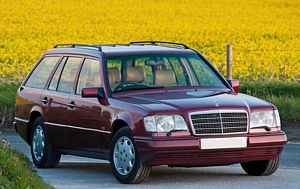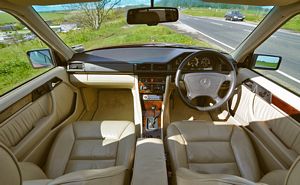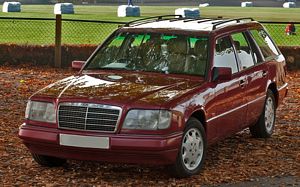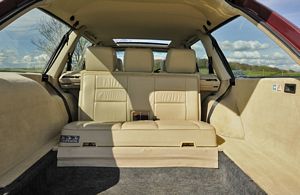|
By accessing/using The Crittenden Automotive Library/CarsAndRacingStuff.com, you signify your agreement with the Terms of Use on our Legal Information page. Our Privacy Policy is also available there. |

Mercedes-Benz W124 estate - an appreciation
|
|---|
|
|
Mercedes-Benz W124 estate - an appreciation
Matt Hubbard
Speedmonkey
October 24, 2012




 Photos courtesy of www.w124.co.uk Photos courtesy of www.w124.co.uk
|
You may not know what a W124 is but take a look at the picture below of a Mercedes-Benz 320 TE Estate. That's a W124. It is the model designation of what we now call the E-Class which was produced from 1985 to 1996. In saloon form the W124 is a so-so car that has often been neglected. In coupe form it is a striking looking beast - essentially a square box with a raked roofline.
It is the estate version of the W124 that has aged well, and still holds a place in the heart of many people who, whilst not necessarily car enthusiasts, know a good quality motor when they see one.
Some history - From 1976 to 1985 Mercedes produced the W123. In estate form it introduced roof rails and extra seats in the boot. In 1985 the W124 was introduced. It was lighter and safer than the W123. Production lasted until 1995 for the saloon version and 1996 for the estate.
The W124's replacement, the W210, was more technologically advanced, as it would be given the advancement of time. But it was also built to a tighter budget. The accountants had taken over at Mercedes-Benz and quality issues became apparent. Steering moved out of alignment, window regulators failed, foglamp wiring melted or burned, differentials started to make a howling noise that could not be addressed - the list goes on. And they rusted - terribly.
The W124 is often described as being over-engineered. This is not necessarily true. It was engineered to last and, if they have been looked after, they do last well.
To drive a W124 today one must remove the modern car mindset. These are old cars. They do not come with all the electronic frippery that todays cars have but don't usually need. To drive a W124 is to experience driving as it should be - in comfort, style and with the driver in control of everything that the car does. (NB - some later models came with traction control as an option)
The driving position is comfortable, with legs outstretched to the perfectly placed pedals. But there is an extra pedal. The parking brake is activated via a small pedal to the left of the footwell (in RHD cars) and released via a handle on the underside of the dash. It is a strange experience at first but becomes comfortable with time.
The dash is simple and straightforward. Revs, speed, fuel level, oil level and engine temperature are the only dials. A row of warning lights sit underneath. The centre console is a lesson in simplicity and elegance. Big buttons, dials for heating and aircon, an automatic gear lever - the vast majority of W124's came with a four speed automatic gearbox. The rest of the interior varies according to the trim level requested by the original buyer but generally all are high quality with the minimum of fuss and accoutrement. Leather is by far the best interior material to go far. Some of the fabrics do date the car.
Passengers in the back seats have plenty of legroom and space. Three can be accommodated at a squeeze, two will ride in comfort. The same cannot quite be said for the passengers in the very back row of seats. Not all cars were specced with the extra sets in the boot, but most were. The design is lovely and simple. The boot floor sits completely flat. Pull up the trapdoors in the floor and fold out the seats. When finished just fold it back up. It takes a few seconds. But they are quite small and only suitable for small children.
The driving experience varies according to the engine. A 200TE comes with smallest engine size, a 4 cylinder, 2 litre with just 118bhp. The auto box is smooth but does tend to 'lose' some of the power. The result is a pretty slow car that takes some winding up to get up to speed. The 230TE, with a 2.3 litre, is also slow. The smallest engine one should consider is the 2.8 litre in the 280TE - with 197bhp. A diesel is also available. It is popular but also slow - the 300TD has 143bhp.
With a decent petrol engine the W124 is a hoot to drive. There are no driving aids. Well balanced power steering, accelerator, slushy auto-box and power straight to the back wheels. It can be driven slowly and smoothly but plant the accelerator and it will eventually woosh forwards. The throttle needs a quick action to really motor otherwise it will select a gear that is too high. In kickdown it drops down to the lowest gear available and gives you as much power to the rear wheels as it can manage. It is possible to induce a nice powerslide when in kickdown at lower speeds.
The steering is set up for an elegant, rather than sporty drive. It is direct but too much input is required for really enthusiastic driving. The suspension is perfectly fine for most situations - the W124 generally wafts along - but is a tad too soft for hoonery.
Living with a W124 today depends entirely on how well it has been treated over the years. Neglected examples can appear clapped out but will often be perfectly functioning cars underneath the veneer of age and neglect. Rust can be a problem. The wheel arch design is such that a layer of mud can build up inside the arch, leading to rust. If this mud has been regularly cleaned out the problem wouldn't have occurred. Boot lids can rust. Boot closing mechanisms can fail. It is a self closing unit. You pull the bootlid down and it electronically clasps together. If it is slammed too many times the mechanism can get bashed about and stop working.
Drivers side seat bolsters are worn through to the guts of the seat in about 50% of all W124s on sale today. This is simple wear and tear and testament that most are in use as daily drivers rather than weekend warriors.
Even if neglected the mechanicals of most W124s should still be in working order. The engines, gearboxes, suspension, differentials and other engineering aspects can last for many thousands of miles. Indeed many Mercedes forums report W124's with 3, 4 or even 500,000 miles on the clock.
Values of W124s vary wildly. Tatty examples can be had for as little as £600. A good quality, relatively rust free 320TE can be had for £1,500. But prices are going up. There are a lot for sale at or above the £5,000 mark. These will come with a leather interior, full service history and spotless bodywork.
Many people, who cannot afford a brand new E Class, opt for one of these looked-after W124s instead of a W210 - and are prepared to pay accordingly. And often the higher priced models will have 100,000 miles or more.
It is a testament to the quality of Mercedes-Benz W124 estates that at 100,000 miles they are considered to have been just run-in.
All photos courtesy of www.124.co.uk - the independent Mercedes estate specialists





















 Photos courtesy of www.w124.co.uk
Photos courtesy of www.w124.co.uk
